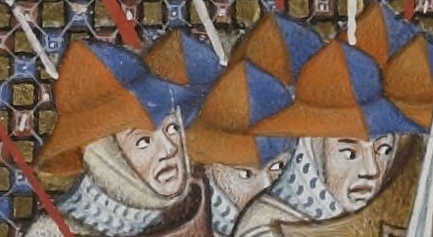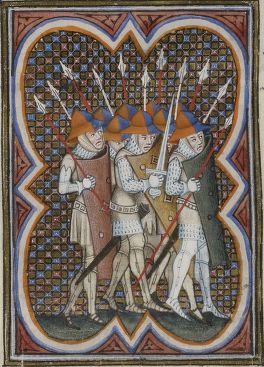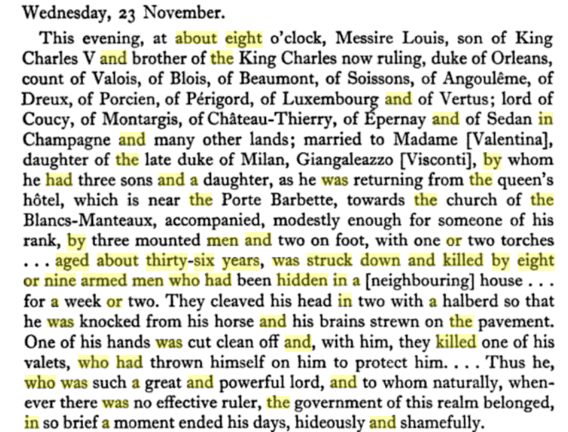What kind of equipment did medieval city/town guards/watchmen use? I've been wondering about this for some time but I can't seem to find much information about it.
You'll need to specify a time and place to any valid answers.
I'm mainly interested in Late Medieval Western Europe.
| Matthew P. Adams wrote: |
| You'll need to specify a time and place to any valid answers. |
Wikipedia defines the Late Middle Ages as 1301-1500. There's a lot of variation within that time frame, and likely variation in Western Europe between Italy and England. As Matthew stated, you need to specify.
I see, I didn't think there would be that much variation with a thing like this. What I'm mainly wondering is if the kind of uniformed guardsmen with polearms and armor that you often see in movies and games have any basis in reality or not.
So 16th or even 17th century style halbardier equipped guard like the Swiss guard in the Vatican?
| Henrik Granlid wrote: |
| So 16th or even 17th century style halbardier equipped guard like the Swiss guard in the Vatican? |
I can't believe I forgot about the Swiss Guard, that answers my question of whether they had basis in reality or not. (I feel silly for asking that now :lol: )
But were there guards like that before the 16th century?
To answer your question; yes. Town watches and garrisoned/garnison troops existed in the late middle ages. In fact they date back to the Roman period.
Perhaps your confused by the often stated fact that there were no standing national armies during this period. Cities most certainly had garrisoned troops, as did some larger towns and most certainly castles and forts ("high walls do not a fortress make"). Some were soldiers or household troops or town guard. Some afforded livery, and others it was BYOB (depending on what you're discussing).
Houscarls date back to the saxon period (or earlier). And the byzantine armies had varangian guardsmen. But those are both far off disparity to your reference of the Swiss guard.
For specific items, not directly related to garrison but with regards to militia, there are even statutes that have survived to this day that some locations had to have So many helmets, hauberks, spears and other items in stores to supply to citizens as the military need arises. In defense, these levied militias would have been "guards" as well.
There are many books on the subject. If you state a specific location and time period, I'm sure you will get many specific suggestions. But I think it's a very general and open ended question, even with the way you have expounded on it.
-Terry
Perhaps your confused by the often stated fact that there were no standing national armies during this period. Cities most certainly had garrisoned troops, as did some larger towns and most certainly castles and forts ("high walls do not a fortress make"). Some were soldiers or household troops or town guard. Some afforded livery, and others it was BYOB (depending on what you're discussing).
Houscarls date back to the saxon period (or earlier). And the byzantine armies had varangian guardsmen. But those are both far off disparity to your reference of the Swiss guard.
For specific items, not directly related to garrison but with regards to militia, there are even statutes that have survived to this day that some locations had to have So many helmets, hauberks, spears and other items in stores to supply to citizens as the military need arises. In defense, these levied militias would have been "guards" as well.
There are many books on the subject. If you state a specific location and time period, I'm sure you will get many specific suggestions. But I think it's a very general and open ended question, even with the way you have expounded on it.
-Terry
The Swiss Guard might wear uniforms that look vaguely 16th- or 17th-century in style, but these were not preserved relics of the Renaissance. This uniform was designed in 1914; Wikipedia says it was inspired by a 1577 fresco by Jacopo Coppi but I've been unable to find anything like it in said fresco:
http://www.universal-prints.com/english/fine-.../index.htm
The closest thing is Raphael's Mass at Bolsena, where the Swiss Guard wore striped but non-uniform Waffenrock:
http://en.wikipedia.org/wiki/The_Mass_at_Bolsena
To return to the original question, it might be a little silly to search specifically for town guards since their equipment didn't differ much from that of soldiers in general. The degree of uniformity obviously varied from place to place; some cities issued livery coats/tabards/aketons/jupons/whatever for their forces, while in other cities the predominant liveries were those of the individual guilds that provided men to the city militia, and in yet others the most common livery would have been the noble or clerical/episcopal overlords'. Some others used smaller distinguishing marks like scarves, badges, or pieces of vegetation. And of course some cities didn't bother with uniforms at all.
In short, if you want to know what medieval town watchmen/guardsmen/militiamen looked like, just check out artwork from the relevant era and period, especially ones that showed the infantry. There are very few sources that can be said to depict town guardsmen/militiamen in particular, such as the Courtrai Chest ( http://en.wikipedia.org/wiki/Courtrai_Chest ) and the (17th-century drawing of the) 14th-century stained-glass picture mentioned by Dirk Breiding here: https://www.academia.edu/8061609/Arms_and_Armor_A_Farewell_to_Persistant_Myths_and_Misconceptions
Additionally, you should probably watch Jean Chandler's videos from this series, since they explain a great deal about the context behind medieval urban militias (especially in Central Europe): https://www.youtube.com/playlist?list=PLi12wFJc02EorLReKFPYihIQC-AM5L_y0
http://www.universal-prints.com/english/fine-.../index.htm
The closest thing is Raphael's Mass at Bolsena, where the Swiss Guard wore striped but non-uniform Waffenrock:
http://en.wikipedia.org/wiki/The_Mass_at_Bolsena
To return to the original question, it might be a little silly to search specifically for town guards since their equipment didn't differ much from that of soldiers in general. The degree of uniformity obviously varied from place to place; some cities issued livery coats/tabards/aketons/jupons/whatever for their forces, while in other cities the predominant liveries were those of the individual guilds that provided men to the city militia, and in yet others the most common livery would have been the noble or clerical/episcopal overlords'. Some others used smaller distinguishing marks like scarves, badges, or pieces of vegetation. And of course some cities didn't bother with uniforms at all.
In short, if you want to know what medieval town watchmen/guardsmen/militiamen looked like, just check out artwork from the relevant era and period, especially ones that showed the infantry. There are very few sources that can be said to depict town guardsmen/militiamen in particular, such as the Courtrai Chest ( http://en.wikipedia.org/wiki/Courtrai_Chest ) and the (17th-century drawing of the) 14th-century stained-glass picture mentioned by Dirk Breiding here: https://www.academia.edu/8061609/Arms_and_Armor_A_Farewell_to_Persistant_Myths_and_Misconceptions
Additionally, you should probably watch Jean Chandler's videos from this series, since they explain a great deal about the context behind medieval urban militias (especially in Central Europe): https://www.youtube.com/playlist?list=PLi12wFJc02EorLReKFPYihIQC-AM5L_y0
English requirements for watchmen in the 14th century usually require men to appear for duty armed as appropriate for their station. Armor requirements were determined by wealth, with men of higher income expected to have more and better equipment. Minimums generally seem to be an aketon, haubergeon, or pair of plates and some sort of helmet, cervelliere, or kettle hat. These requirements generally get strengthened as the century progresses to include gauntlets and arm harness. Arms might be simple spears or swords and long daggers rather than other polearms.
Towns would sometimes provide livery. Norwich equipped some men with red surcoats, for example. An excellent depiction appears in a Grandes Chroniques de France, BNF Français 2813, of 1375-1380 where the soldiers all have similar chapel de fer in the city's colors.
http://gallica.bnf.fr/ark:/12148/btv1b84472995/f830.item
[ Linked Image ]
 Attachment: 92.52 KB
Attachment: 92.52 KB

 Attachment: 34.59 KB
Attachment: 34.59 KB

Towns would sometimes provide livery. Norwich equipped some men with red surcoats, for example. An excellent depiction appears in a Grandes Chroniques de France, BNF Français 2813, of 1375-1380 where the soldiers all have similar chapel de fer in the city's colors.
http://gallica.bnf.fr/ark:/12148/btv1b84472995/f830.item
[ Linked Image ]


This differed considerably from town to town, even at the same age. More so when you are looking in a time space of 200 or more years.
Quite often it was not only dependent on wealth but also profession. In certain towns, the different professions had to do duty on specified days (e.g. London) whereas in other towns the guard duty was divided according to districts (e.g. Vienna).
Then there is also the instance where the time spent in town was also taken into consideration so that a newcomer didn't need the full kit right away.
So, please specify
Quite often it was not only dependent on wealth but also profession. In certain towns, the different professions had to do duty on specified days (e.g. London) whereas in other towns the guard duty was divided according to districts (e.g. Vienna).
Then there is also the instance where the time spent in town was also taken into consideration so that a newcomer didn't need the full kit right away.
So, please specify
If I narrow it down to 15th century England is that specific enough? Especially the WotR era.
They would be equipped as mentioned above by their wealth. I have an article that came out last month on 2nd half of the 15th armour from the Richard III Foundation.
Basically there is a pretty broad spectrum of equipment for commoners from no armour to rather complete armour and barely armed to having multiple weapons.
IN Southampton the guard is required to well armed, which I suspect is as vague then as it is now. I would guess they wanted to ensure the town guard was able to deal with day to day issues. There is indication in times of war of this being increased though.
RPM
Basically there is a pretty broad spectrum of equipment for commoners from no armour to rather complete armour and barely armed to having multiple weapons.
IN Southampton the guard is required to well armed, which I suspect is as vague then as it is now. I would guess they wanted to ensure the town guard was able to deal with day to day issues. There is indication in times of war of this being increased though.
RPM
Try Anthony Goodman's The Wars of the Roses: military activity and English society, 1452-97. The most important data point presented in the book is the Bridport muster roll, which wasn't really a muster roll (more of a wapenshaw or a militia audit document); it shows the considerable variation in equipment even among troops in the same category. For example, here's a simpler breakdown for the archers:
http://willscommonplacebook.blogspot.com/2014...-1457.html
http://willscommonplacebook.blogspot.com/2014...-1457.html
Did town guards use any specialized weapons or equipment? I read they liked shorter weapons that were more maneuverable in cramped urban spaces and narrow streets, which makes sense. I also read they liked maces and war hammers, but a member here strongly objected to the idea that town guards would want or need what are usually considered anti-armor weapons. I also wondered about shorter pole weapons. Lanterns would also be needed, and when sword and lantern fencing styles appeared I would think that would be very useful to town guards. I assume that when the odd shield/lantern combo devices were popular town guards used them as well.
Any information or observations you all have on this would be most welcome.
Any information or observations you all have on this would be most welcome.
I found a simple lantern buckler in the Royal Amoury Collection.
https://collections.royalarmouries.org/object/rac-object-17313.html
That one is very ornate and likely designed for duelling at night. I would think simpler ones would have been available and popular with town guard troops.
https://collections.royalarmouries.org/object/rac-object-17313.html
That one is very ornate and likely designed for duelling at night. I would think simpler ones would have been available and popular with town guard troops.
Kirk,
After years of studying town records I have never seen anything that indicate them using specific weapons because they were in town. The roads might be cramped but they are wider than you may be thinking. the main streets of Southampton, which was a rather small town would have enabled you to use pretty much any weapon you needed. In fact it seems to have been several carts wide. Smaller alleyways might have been harder but I really doubt they chose a new set of weapons for guard duty.
If you look up some of my articles they include specifics of weapons and armour for commoners, townsmen included,but I do not think you will find them any different.
Yes some type of lantern for light but that is pretty much it. Spears, bows and swords seem pretty common in art and possibly text, though the word baculum comes up in town records and we are not sure if it is a club, mace, spear or any stick based or shafted weapon.
I have seen very limited info on bucklers in town, though various shields do show up in personal and town inventories.
Best of luck,
Randall
After years of studying town records I have never seen anything that indicate them using specific weapons because they were in town. The roads might be cramped but they are wider than you may be thinking. the main streets of Southampton, which was a rather small town would have enabled you to use pretty much any weapon you needed. In fact it seems to have been several carts wide. Smaller alleyways might have been harder but I really doubt they chose a new set of weapons for guard duty.
If you look up some of my articles they include specifics of weapons and armour for commoners, townsmen included,but I do not think you will find them any different.
Yes some type of lantern for light but that is pretty much it. Spears, bows and swords seem pretty common in art and possibly text, though the word baculum comes up in town records and we are not sure if it is a club, mace, spear or any stick based or shafted weapon.
I have seen very limited info on bucklers in town, though various shields do show up in personal and town inventories.
Best of luck,
Randall
| Randall Moffett wrote: |
| Yes some type of lantern for light but that is pretty much it. Spears, bows and swords seem pretty common in art and possibly text, though the word baculum comes up in town records and we are not sure if it is a club, mace, spear or any stick based or shafted weapon.
|
Well, it's obviously not referring to the "penis bone" in some mammals, of the same name. However, an interesting reference from "The Study of the Bayeux Tapestry" (Google Books quick reference) seems to believe the baculum is a slightly tapering wooden baton with occasional lateral projections of similar size to a mace but with no heavy head; and often used by authority figures. That said, maybe it's one of the earliest -or alternate- terms/forms for a truncheon, baton, or billy club and could look a bit like a bar mace? Thoughts?
To provide a little example of a 'street fight'
 Attachment: 254.72 KB
Attachment: 254.72 KB


I think it would depend upon what threats the town guard was formed to handle. Town drunks and petty thieves would likely be handled with clubs or maces (functionally a club with extras), since cutting off limbs or having townspeople die from blood loss or infection has often been frowned-upon. (Note 19th and early 20th century law enforcement in USA and England). Maces, decorative morgensterns, and holy water sprinklers have often been used as a symbol of authority as well as being functional weapons.
If an uprising or armed groups of ruffians (gangs) were a possibility, we're now talking about armor and edged weapons. At times, "sword staves" or corseque might have been used, as well as common military weapons.
http://myArmoury.com/talk/viewtopic.php?t=1248
Image credit: Waldman's "Hafted Weapons in Medieval and Renaissance Europe......"
As previously mentioned, we can only speak to particular examples and speculate on the rest.
 Attachment: 48.74 KB
Attachment: 48.74 KB
[ Download ]
If an uprising or armed groups of ruffians (gangs) were a possibility, we're now talking about armor and edged weapons. At times, "sword staves" or corseque might have been used, as well as common military weapons.
http://myArmoury.com/talk/viewtopic.php?t=1248
Image credit: Waldman's "Hafted Weapons in Medieval and Renaissance Europe......"
As previously mentioned, we can only speak to particular examples and speculate on the rest.
[ Download ]
Page 1 of 2
You cannot post new topics in this forumYou cannot reply to topics in this forum
You cannot edit your posts in this forum
You cannot delete your posts in this forum
You cannot vote in polls in this forum
You cannot attach files in this forum
You can download files in this forum
All contents © Copyright 2003-2006 myArmoury.com — All rights reserved
Discussion forums powered by phpBB © The phpBB Group
Switch to the Full-featured Version of the forum
Discussion forums powered by phpBB © The phpBB Group
Switch to the Full-featured Version of the forum